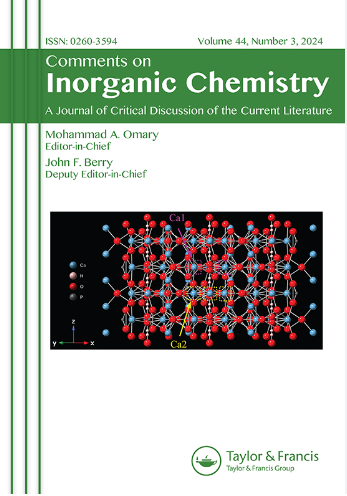All That Glitters Is Not Gold: A Computational Study of Covalent vs Metallophilic Bonding in Bimetallic Complexes of d10 Metal Centers—A Tribute to Al Cotton on the Tenth Anniversary of His Passing
IF 3.8
3区 化学
Q1 CHEMISTRY, INORGANIC & NUCLEAR
引用次数: 10
Abstract
As the tenth year that follows the premature passing of the inorganic chemistry legend F. Albert (Al) Cotton comes to a close, we provide some soul food that we believe Al would have enjoyed as he looks down upon two generations of disciples, a grandchild and two great grandchildren, in his scientific family tree. This article also represents a new tradition by which the editors of Comments on Inorganic Chemistry wish to lead by example, whereby we start publishing original research content that nonetheless preserves the journal’s identity as a niche for “critical discussion of the current literature” of inorganic chemistry. Thus, we show novel demonstrations of a posteriori validation and a priori prediction of possible counterintuitive covalent M-M’ bonds—after and before synthesis, respectively—contrasted with non-covalent M···M interactions of the metallophilic type in bridge-dimeric systems of d10 metal centers. Mixing of (n + 1)s0/p0 orbitals with (n)d10 orbitals in the former heterobimetallics case—and lack thereof in the latter homobimetallics case—is hypothesized to be responsible for the presence or absence of covalency, respectively. However, we also demonstrate that the consequent d-s’ and/or d-p’ orbital mixing/hybridization can occur even in homobimetallic complexes that contain asymmetric bridging ligands (e.g., with -S^C- donor atoms that lead to orbital interactions between M-S and M-C fragments). Hence, the “control” metallophilic case for the hypothesized d10-d10 polar-covalent bonding herein is best manifest by M2(P^P)2 homobimetallics vis-à-vis M2(S^C)2 embodiments. Finally, we also offer a point/counterpoint commentary to the readers to contrast factors that argue for covalency vs metallophilicity and forewarn against exaggerating the extent of covalent bonding in such d10-d10 species. Thus, scrutinizing the various theoretical parameters has pointed to M-M’ and M-M partially bonded S^C-bridge dinuclear d10 complexes vis-à-vis the classic Cotton-type multiple metal-metal bond description in d0所有闪光的都不是黄金:d10金属中心双金属配合物中共价与亲金键的计算研究——致敬Al Cotton逝世十周年
无机化学传奇人物f·阿尔伯特·科顿(F. Albert (Al) Cotton)英年早逝的第十个年头即将结束,我们提供了一些灵魂食物,我们相信,当阿尔在他的科学家谱中俯视两代弟子,一个孙子和两个曾孙时,他一定会享受到这些食物。这篇文章也代表了《无机化学评论》的编辑们希望以身作则的新传统,即我们开始发表原创研究内容,但仍保留了该杂志作为无机化学“当前文献批判性讨论”的定位。因此,我们展示了对可能的反直觉共价M-M键的事后验证和先验预测,分别在合成后和合成前,与d10金属中心的桥式二聚体体系中亲金型的非共价M···M相互作用进行了对比。在前一种异相金属的情况下,(n + 1) 0/p0轨道与(n)d10轨道的混合,以及在后一种均相金属的情况下的缺乏,被假设分别是共价存在或不存在的原因。然而,我们也证明了d-s '和/或d-p '轨道混合/杂化甚至可以发生在含有不对称桥接配体的同双金属配合物中(例如,与-s ^C-供体原子导致M-S和M-C片段之间的轨道相互作用)。因此,本文假设的d10-d10极性共价键的“控制”亲金性情况最好通过M2(P^P)2均相金属物与-à-vis M2(S^C)2实施例相体现。最后,我们还为读者提供了一个观点/对位评论,以对比共价性与亲金性的争论因素,并警告不要夸大此类d10-d10物种的共价键的程度。因此,仔细研究各种理论参数,指出M-M '和M-M部分成键的S^ c桥双核d10配合物与-à-vis中经典的棉花型多金属-金属键描述
本文章由计算机程序翻译,如有差异,请以英文原文为准。
求助全文
约1分钟内获得全文
求助全文
来源期刊

Comments on Inorganic Chemistry
化学-无机化学与核化学
CiteScore
9.00
自引率
1.90%
发文量
18
审稿时长
>12 weeks
期刊介绍:
Comments on Inorganic Chemistry is intended as a vehicle for authoritatively written critical discussions of inorganic chemistry research. We publish focused articles of any length that critique or comment upon new concepts, or which introduce new interpretations or developments of long-standing concepts. “Comments” may contain critical discussions of previously published work, or original research that critiques existing concepts or introduces novel concepts.
Through the medium of “comments,” the Editors encourage authors in any area of inorganic chemistry - synthesis, structure, spectroscopy, kinetics and mechanisms, theory - to write about their interests in a manner that is both personal and pedagogical. Comments is an excellent platform for younger inorganic chemists whose research is not yet widely known to describe their work, and add to the spectrum of Comments’ author profiles, which includes many well-established inorganic chemists.
 求助内容:
求助内容: 应助结果提醒方式:
应助结果提醒方式:


